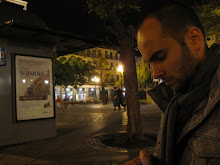Semantic Web
The Semantic Web is a web of data. There is lots of data we all use every day, and its not part of the web. I can see my bank statements on the web, and my photographs, and I can see my appointments in a calendar. But can I see my photos in a calendar to see what I was doing when I took them? Can I see bank statement lines in a calendar?
Why not? Because we don't have a web of data. Because data is controlled by applications, and each application keeps it to itself.
The Semantic Web is about two things. It is about common formats for integration and combination of data drawn from diverse sources, where on the original Web mainly concentrated on the interchange of documents. It is also about language for recording how the data relates to real world objects. That allows a person, or a machine, to start off in one database, and then move through an unending set of databases which are connected not by wires but by being about the same thing.
From: W3C
Posted in data, Semantic Web, web, web semantic
XFN
XFN puts a human face on linking. As more people have come online and begun to form social networks, services such as Technorati and Feedster have arisen in an attempt to show how the various nodes are connected. Such services are useful for discovering the mechanical connections between nodes, but they do not uncover the human relationships between the people responsible for the nodes.
XFN outlines the relationships between individuals by defining a small set of values that describe personal relationships. In HTML and XHTML documents, these are given as values for the rel attribute on a hyperlink. XFN allows authors to indicate which of the weblogs they read belong to friends, whom they've physically met, and other personal relationships. Using XFN values, which can be listed in any order, people can humanize their blogrolls and links pages, both of which have become a common feature of weblogs.
In sufficiently modern browsers, authors using XFN can easily style all links of a particular type; thus, friends could be boldfaced, co-workers italicized, and so on. It is also the hope of the authors that this practice becomes widespread enough to allow the creation of a service that charts personal (as opposed to purely mechanical) links between weblogs and the people responsible for them.
From: XFN
Posted in linking, social networks, xfn html, xhtml
FOAF and the Semantic Web
FOAF, like the Web itself, is a linked information system. It is built using decentralised Semantic Web technology, and has been designed to allow for integration of data across a variety of applications, Web sites and services, and software systems. To achieve this, FOAF takes a liberal approach to data exchange. It does not require you to say anything at all about yourself or others, nor does it place any limits on the things you can say or the variety of Semantic Web vocabularies you may use in doing so. This current specification provides a basic "dictionary" of terms for talking about people and the things they make and do.
FOAF was designed to be used alongside other such dictionaries ("schemas" or "ontologies"), and to beusable with the wide variety of generic tools and services that have been created for the Semantic Web. For example, the W3C work on SPARQL provides us with a rich query language for consulting databases of FOAF data, while the SKOS initiative explores in more detail than FOAF the problem of describing topics, categories, "folksonomies" and subject hierarchies. Meanwhile, other W3C groups are working on improved mechanisms for encoding all kinds of RDF data (including but not limited to FOAF) within Web pages: see the work of the GRDDL and RDFa efforts for more detail. The Semantic Web provides us with an architecture for collaboration, allowing complex technical challenges to be shared by a loosely-coordinated community of developers.
The FOAF project is based around the use of machine readable Web homepages for people, groups, companies and other kinds of thing. To achieve this we use the "FOAF vocabulary" to provide a collection of basic terms that can be used in these Web pages. At the heart of the FOAF project is a set of definitions designed to serve as a dictionary of terms that can be used to express claims about the world. The initial focus of FOAF has been on the description of people, since people are the things that link together most of the other kinds of things we describe in the Web: they make documents, attend meetings, are depicted in photos, and so on.
From: FoaFSpecification
Posted in foaf, FOAF project, linking, Semantic Web, web
